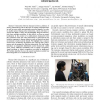Free Online Productivity Tools
i2Speak
i2Symbol
i2OCR
iTex2Img
iWeb2Print
iWeb2Shot
i2Type
iPdf2Split
iPdf2Merge
i2Bopomofo
i2Arabic
i2Style
i2Image
i2PDF
iLatex2Rtf
Sci2ools
ROMAN
2007
IEEE
2007
IEEE
Real-time acoustic source localization in noisy environments for human-robot multimodal interaction
— Interaction between humans involves a plethora of sensory information, both in the form of explicit communication as well as more subtle unconsciously perceived signals. In order to enable natural human-robot interaction, robots will have to acquire the skills to detect and meaningfully integrate information from multiple modalities. In this article, we focus on sound localization in the context of a multi-sensory humanoid robot that combines audio and video information to yield natural and intuitive responses to human behavior, such as directed eye-head movements towards natural stimuli. We highlight four common sound source localization algorithms and compare their performance and advantages for real-time interaction. We also briefly introduce an integrated distributed control framework called DVC, where additional modalities such as speech recognition, visual tracking, or object recognition can easily be integrated. We further describe the way the sound localization module has ...
| Added | 04 Jun 2010 |
| Updated | 04 Jun 2010 |
| Type | Conference |
| Year | 2007 |
| Where | roman |
| Authors | Vlad M. Trifa, Ansgar Koene, Jan Morén, Gordon Cheng |
Comments (0)

